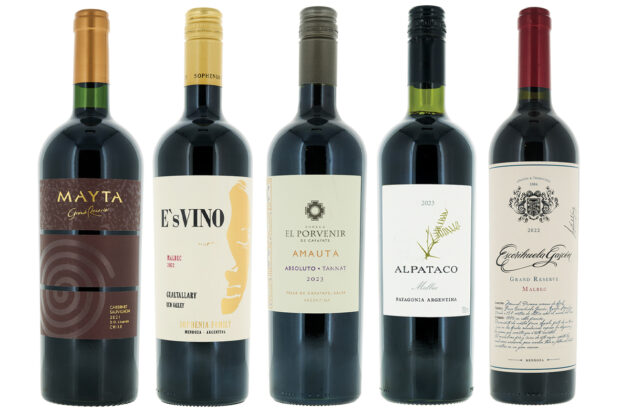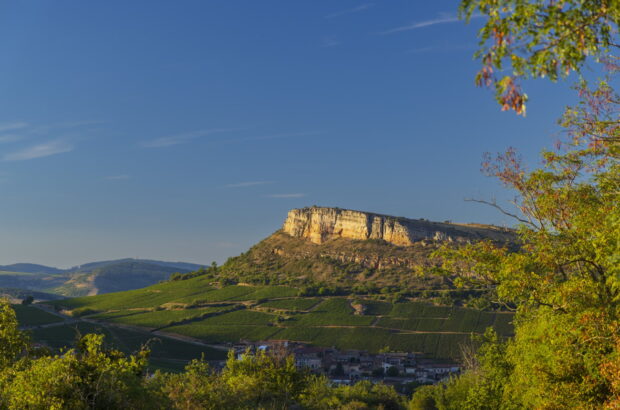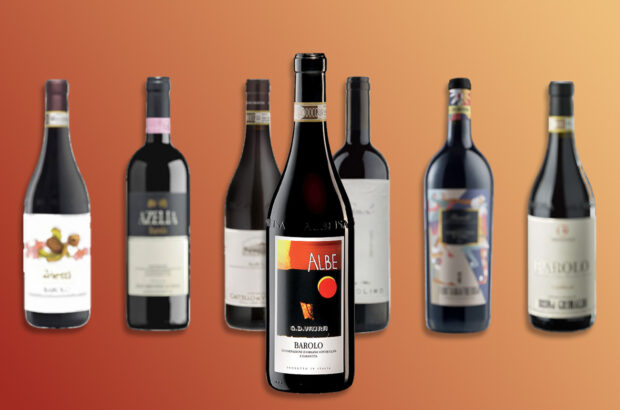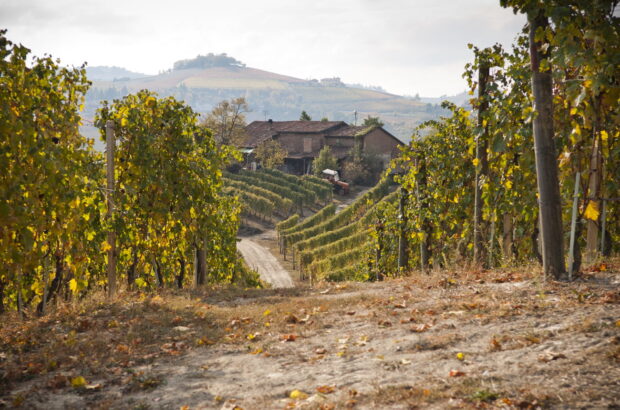It seems that everywhere you turn in the wine world, you’ll find a grape called Malvasia – according to the ultimate scientific grapevine database VIVC.de, there are as many as 290 of them. And many are delicious, so are definitely worth exploring.
The name ‘Malvasia’ is widespread across the Mediterranean basin and into the Atlantic as far as Madeira and the Canary Islands, and it would be logical to assume there’s a family connection.
However, in these days of DNA analysis, there are no dark family secrets and scientists have worked out that most grapes going by the name Malvasia are unrelated to each other – and in many cases, the name has been attached to other grapes entirely. The mystery is why Malvasia became such a popular name and where it came from.
Scroll down to see notes and scores for 12 outstanding Malvasia wines to seek out
{"content":"PC9wPgo8aDI+Q2VudHVyaWVzIG9mIGhpc3Rvcnk8L2gyPgo8cD5UaGVyZSBhcmUgc2V2ZXJhbCBjb2xvdXJmdWwgaGlzdG9yaWNhbCB0YWxlcyBhYm91dCBNYWx2YXNpYS4gSW4gPGVtPlJpY2hhcmQgSUlJPC9lbT4sIGZpcnN0IHB1Ymxpc2hlZCBpbiAxNTk3LCBTaGFrZXNwZWFyZSByZWZlcnMgdG8gdGhlIER1a2Ugb2YgQ2xhcmVuY2UgYmVpbmcgZHJvd25lZCBpbiBhIGJ1dHQgb2YgTWFsbXNleSB3aW5lICh0aGUgbmFtZSBmb3IgdGhlIHN3ZWV0ZXN0IE1hbHZhc2lhIHdpbmUgZnJvbSBNYWRlaXJhKS48L3A+CjxwPjxkaXYgY2xhc3M9ImFkLWNvbnRhaW5lciBhZC1jb250YWluZXItLW1vYmlsZSI+PGRpdiBpZD0icG9zdC1pbmxpbmUtMiIgY2xhc3M9ImlwYy1hZHZlcnQiPjwvZGl2PjwvZGl2PjwvcD4KPHA+PHN0cm9uZz48YSBocmVmPSJodHRwczovL3d3dy5kZWNhbnRlci5jb20vd2luZS1uZXdzL2xlb25hcmRvLWRhLXZpbmNpLXZpbmV5YXJkLXJldml2ZWQtaW4tY2VudHJhbC1taWxhbi0xNjQyLyIgdGFyZ2V0PSJfYmxhbmsiIHJlbD0ibm9vcGVuZXIiPkluIDE0OTgsIExlb25hcmRvIGRhIFZpbmNpIGhhZCBhIHNtYWxsIHZpbmV5YXJkIG9mIDE2IHJvd3Mgb2YgdmluZXMgaW4gTWlsYW4gZ3JhbnRlZCB0byBoaW0gYnkgRHVrZSBMdWRvdmljbyBNYXJpYSDigJhJbCBNb3Jv4oCZIFNmb3J6YTwvYT48L3N0cm9uZz4sIGFzIGEgcmV3YXJkIGZvciBoaXMgd29ya3MgYXMgaGUgd2FzIGNvbXBsZXRpbmcgPGVtPlRoZSBMYXN0IFN1cHBlcjwvZW0+LiBHZW5ldGljIGFuYWx5c2lzIG9mIHRyYWNlcyBvZiB2aW5lIHJvb3RzIHN1Z2dlc3RzIHRoYXQgdGhlIHZpbmVzIHdlcmUgTWFsdmFzaWEgZGkgQ2FuZGlhIEFyb21hdGljYSDigJMgdGhlIHZpbmV5YXJkIGhhcyBiZWVuIHJlcGxhbnRlZCB3aXRoIE1hbHZhc2lhIGFuZCBtYWtlcyB3aW5lIGFnYWluIHRvZGF5LjwvcD4KPHA+QnV0IHdyaXR0ZW4gaGlzdG9yeSBnb2VzIGJhY2sgbXVjaCBmdXJ0aGVyLCB0byAxMjE0LCB3aGVuIHRoZXJlIGlzIGEgcmVmZXJlbmNlIHRvIE1hbHZhc2lhIHdpbmUgYmVpbmcgc2VydmVkIOKAmGluIGFidW5kYW5jZeKAmSBhdCBhIGNodXJjaCBkZWxlZ2F0aW9uIGluIENvbnN0YW50aW5vcGxlLCBzbyBpdCB3YXMgYWxyZWFkeSBsaWtlbHkgdG8gaGF2ZSBiZWVuIGEgcHJlc3RpZ2lvdXMgd2luZSBieSB0aGVuLjwvcD4KPHA+QXQgdGhhdCB0aW1lLCBpdCB3YXMgY2xvc2VseSBjb25uZWN0ZWQgdG8gTW9uZW12YXNpYSBpbiA8c3Ryb25nPjxhIGhyZWY9Imh0dHBzOi8vd3d3LmRlY2FudGVyLmNvbS9wcmVtaXVtL2dyZWVrLW9keXNzZXktb2xseS1zbWl0aHMtcGljay1vZi10aGUtcmVnaW9ucy1hbmQtd2luZXMtNDgzMTE3LyIgdGFyZ2V0PSJfYmxhbmsiIHJlbD0ibm9vcGVuZXIiPkdyZWVjZTwvYT48L3N0cm9uZz4sIGEgQnl6YW50aW5lIGZvcnRyZXNzIHRvd24gYnVpbHQgb24gYSByb2NrIGluIHRoZSBMYWNvbmlhIHJlZ2lvbiBvZiBzb3V0aGVhc3QgPHN0cm9uZz48YSBocmVmPSJodHRwczovL3d3dy5kZWNhbnRlci5jb20vd2luZS10cmF2ZWwvYS13aW5lLWxvdmVycy1ndWlkZS10by10aGUtcGVsb3Bvbm5lc2UtNDMxOTE1LyIgdGFyZ2V0PSJfYmxhbmsiIHJlbD0ibm9vcGVuZXIiPlBlbG9wb25uZXNlLjwvYT48L3N0cm9uZz4gSXQgd2FzIGFsc28gdGhlIHRyYWRpbmcgY2VudHJlIG9mIHRoZSBsYXJnZXIgYWRtaW5pc3RyYXRpdmUgYXJlYSBvZiBNb25lbXZhc2lhLiBUaGUgVmVuZXRpYW4gcnVsZXJzIG9mIHRoZSBmb3J0cmVzcyBvZiBNb25lbXZhc2lhIG5hbWVkIGl0IE1hbHZhc2lhIGFuZCB1c2VkIHRoZSBuYW1lIGZvciB0aGUgd2luZSB0aGF0IHRoZXkgZXhwb3J0ZWQuPC9wPgo8ZGl2IGNsYXNzPSJhZC1jb250YWluZXIgYWQtY29udGFpbmVyLS1tb2JpbGUiPjxkaXYgaWQ9InBvc3QtaW5saW5lLTMiIGNsYXNzPSJpcGMtYWR2ZXJ0Ij48L2Rpdj48L2Rpdj4KPHA+SXQgc2VlbXMgdGhhdCBvbmx5IHN3ZWV0IHdpbmUgZnJvbSBzdW5kcmllZCBncmFwZXMsIG9yIHNvbWV0aW1lcyBib2lsZWQgbXVzdCwgd2FzIHN0YWJsZSBlbm91Z2ggdG8gYmUgc2hpcHBlZCBsb25nIGRpc3RhbmNlcywgYW5kIGJ5IHRoZSAxNHRoIGNlbnR1cnksIHJlY29yZHMgaW5kaWNhdGUgdGhhdCB0aGUgd2luZSBmcm9tIHRoaXMgcmVnaW9uIHdhcyBjYWxsZWQgTWFsdmFzaWEgaW4gdGhlIG1hcmtldHMgb2YgPHN0cm9uZz48YSBocmVmPSJodHRwczovL3d3dy5kZWNhbnRlci5jb20vd2luZS10cmF2ZWwvbXktdmVuaWNlLTQ3NzY4Mi8iIHRhcmdldD0iX2JsYW5rIiByZWw9Im5vb3BlbmVyIj5WZW5pY2U8L2E+PC9zdHJvbmc+OyBldmVuIHdpbmUgc2hvcHMgd2VyZSBuYW1lZCBNYWx2YXNpZS48L3A+CjxwPk9yaWdpbmFsbHkgdGhpcyBuYW1lIHJlZmVycmVkIHRvIGl0cyBvcmlnaW4g4oCTIGl0IHdhcyBjb25zaWRlcmVkIGV4Y2VsbGVudCwgd2l0aCBhIHJlcHV0YXRpb24gc28gZ29vZCB0aGF0IGl0IGJlY2FtZSBhIGx1eHVyeSBwcm9kdWN0IHVuZGVyIHRoZSBuYW1lIE1hbHZhc2lhLU1vbmVtdmFzaWEuIEFzIHRyYWRlIGdyZXcsIHRoZSByZWdpb24gY291bGRu4oCZdCBrZWVwIHVwIHdpdGggZGVtYW5kIGFuZCB0cmFkZXJzIHN0YXJ0ZWQgdG8g4oCYZnJhbmNoaXNl4oCZIHRoZSBicmFuZCB0byBwbGFjZXMgaW4gR3JlZWNlIGJleW9uZCBMYWNvbmlhIChQYXJvcyBhbmQgQ3JldGUpLjwvcD4KPGRpdiBjbGFzcz0iYWQtY29udGFpbmVyIGFkLWNvbnRhaW5lci0tbW9iaWxlIj48ZGl2IGlkPSJwb3N0LWlubGluZS00IiBjbGFzcz0iaXBjLWFkdmVydCI+PC9kaXY+PC9kaXY+CjxkaXYgaWQ9ImF0dGFjaG1lbnRfNTM3NzY5IiBzdHlsZT0id2lkdGg6IDYxMHB4IiBjbGFzcz0id3AtY2FwdGlvbiBhbGlnbm5vbmUiPjxpbWcgZmV0Y2hwcmlvcml0eT0iaGlnaCIgZGVjb2Rpbmc9ImFzeW5jIiBhcmlhLWRlc2NyaWJlZGJ5PSJjYXB0aW9uLWF0dGFjaG1lbnQtNTM3NzY5IiBjbGFzcz0ibGF6eWxvYWQgYmx1ci11cCBzaXplLWZ1bGwgd3AtaW1hZ2UtNTM3NzY5IiBkYXRhLXByb2Nlc3NlZCBzcmM9Imh0dHBzOi8vd3d3LmRlY2FudGVyLmNvbS93cC1jb250ZW50L3RoZW1lcy9zaW1iYS10aGVtZS9hc3NldHMvaW1hZ2VzL3BsYWNlaG9sZGVyLnBuZyIgZGF0YS1zcmM9Imh0dHBzOi8va2V5YXNzZXRzLnRpbWVpbmN1ay5uZXQvaW5zcGlyZXdwL2xpdmUvd3AtY29udGVudC91cGxvYWRzL3NpdGVzLzM0LzIwMjQvMDkvREVDMzAyLm1hbHZhc2lhLm1kZzYyMzhfY3JlZGl0X25ldmVuX2p1cmphay5qcGciIGFsdD0iIiB3aWR0aD0iNjAwIiBoZWlnaHQ9IjQwMCIgZGF0YS1zaXplcz0iYXV0byIgZGF0YS1zcmNzZXQ9Imh0dHBzOi8va2V5YXNzZXRzLnRpbWVpbmN1ay5uZXQvaW5zcGlyZXdwL2xpdmUvd3AtY29udGVudC91cGxvYWRzL3NpdGVzLzM0LzIwMjQvMDkvREVDMzAyLm1hbHZhc2lhLm1kZzYyMzhfY3JlZGl0X25ldmVuX2p1cmphay5qcGcgNjAwdywgaHR0cHM6Ly9rZXlhc3NldHMudGltZWluY3VrLm5ldC9pbnNwaXJld3AvbGl2ZS93cC1jb250ZW50L3VwbG9hZHMvc2l0ZXMvMzQvMjAyNC8wOS9ERUMzMDIubWFsdmFzaWEubWRnNjIzOF9jcmVkaXRfbmV2ZW5fanVyamFrLTMwMHgyMDAuanBnIDMwMHcsIGh0dHBzOi8va2V5YXNzZXRzLnRpbWVpbmN1ay5uZXQvaW5zcGlyZXdwL2xpdmUvd3AtY29udGVudC91cGxvYWRzL3NpdGVzLzM0LzIwMjQvMDkvREVDMzAyLm1hbHZhc2lhLm1kZzYyMzhfY3JlZGl0X25ldmVuX2p1cmphay0xMzV4OTAuanBnIDEzNXcsIGh0dHBzOi8va2V5YXNzZXRzLnRpbWVpbmN1ay5uZXQvaW5zcGlyZXdwL2xpdmUvd3AtY29udGVudC91cGxvYWRzL3NpdGVzLzM0LzIwMjQvMDkvREVDMzAyLm1hbHZhc2lhLm1kZzYyMzhfY3JlZGl0X25ldmVuX2p1cmphay0zMjB4MjEzLmpwZyAzMjB3IiBzaXplcz0iKG1heC13aWR0aDogNjAwcHgpIDEwMHZ3LCA2MDBweCIgLz48cCBpZD0iY2FwdGlvbi1hdHRhY2htZW50LTUzNzc2OSIgY2xhc3M9IndwLWNhcHRpb24tdGV4dCI+TWFsdmFzaWEgSXN0cmlhbmEgcmlwZW5pbmcgb24gdGhlIHZpbmUuIENyZWRpdDogTmV2ZW4gSnVyamFrLjwvcD48L2Rpdj4KPHA+QXQgdGhlIHBlYWsgb2YgdHJhZGUsIHRoZSBxdWFudGl0aWVzIHJlcXVpcmVkIHdlcmUgc28gbGFyZ2UgdGhhdCA8c3Ryb25nPjxhIGhyZWY9Imh0dHBzOi8vd3d3LmRlY2FudGVyLmNvbS9sZWFybi9kaWZmZXJlbmNlLW11c2NhdC1tb3NjYXRlbC1tb3NjYXRvLTQ2Mzg1Mi8iIHRhcmdldD0iX2JsYW5rIiByZWw9Im5vb3BlbmVyIj5NdXNjYXRzPC9hPiA8L3N0cm9uZz5hbmQgb3RoZXIgaW5kaWdlbm91cyBncmFwZSB2YXJpZXRpZXMgd2VyZSBiZWluZyB1c2VkLCBhbmQgYnkgdGhlIGVuZCBvZiB0aGUgMTZ0aCBjZW50dXJ5LCBvbmx5IGEgaGFuZGZ1bCBvZiBwdXJlIE1hbHZhc2lhcyBmcm9tIHRoZSBvcmlnaW5hbCBncmFwZSB3ZXJlIHN0aWxsIGJlaW5nIHByb2R1Y2VkLjwvcD4KPGRpdiBjbGFzcz0iYWQtY29udGFpbmVyIGFkLWNvbnRhaW5lci0tbW9iaWxlIj48ZGl2IGlkPSJwb3N0LWlubGluZS01IiBjbGFzcz0iaXBjLWFkdmVydCI+PC9kaXY+PC9kaXY+CjxwPkdyYWR1YWxseSB0aGUgbmFtZSBiZWNhbWUgYSBkZXNjcmlwdGlvbiBvZiBzdHlsZSByYXRoZXIgdGhhbiBnZW9ncmFwaGljYWwgb3JpZ2luIOKAkyBzb21ldGhpbmcgdGhhdCBoYXMgaGFwcGVuZWQgbnVtZXJvdXMgdGltZXMgZWxzZXdoZXJlIHdpdGggbmFtZXMgc3VjaCBhcyA8c3Ryb25nPjxhIGhyZWY9Imh0dHBzOi8vd3d3LmRlY2FudGVyLmNvbS93aW5lL3dpbmUtcmVnaW9ucy9jaGFtcGFnbmUvIiB0YXJnZXQ9Il9ibGFuayIgcmVsPSJub29wZW5lciI+Q2hhbXBhZ25lPC9hPjwvc3Ryb25nPiwgPHN0cm9uZz48YSBocmVmPSJodHRwczovL3d3dy5kZWNhbnRlci5jb20vd2luZS93aW5lLXJlZ2lvbnMvc3BhaW4vc2hlcnJ5LyIgdGFyZ2V0PSJfYmxhbmsiIHJlbD0ibm9vcGVuZXIiPlNoZXJyeTwvYT48L3N0cm9uZz4sIDxhIGhyZWY9Imh0dHBzOi8vd3d3LmRlY2FudGVyLmNvbS9wb3J0LyIgdGFyZ2V0PSJfYmxhbmsiIHJlbD0ibm9vcGVuZXIiPjxzdHJvbmc+UG9ydDwvc3Ryb25nPiA8L2E+YW5kIDxzdHJvbmc+PGEgaHJlZj0iaHR0cHM6Ly93d3cuZGVjYW50ZXIuY29tL3dpbmUvd2luZS1yZWdpb25zL2J1cmd1bmR5LXdpbmUvIiB0YXJnZXQ9Il9ibGFuayIgcmVsPSJub29wZW5lciI+QnVyZ3VuZHk8L2E+PC9zdHJvbmc+LCBiZWZvcmUgdGhlIEVVIGJlY2FtZSBwcm90ZWN0aXZlLjwvcD4KPHA+QnkgMTU0MCwgdGhlIE1vbmVtdmFzaWEgYXJlYSBjYW1lIHVuZGVyIE90dG9tYW4gcnVsZSwgd2hpY2ggZGlzcnVwdGVkIHdpbmUgcHJvZHVjdGlvbiBoZXJlOyBob3dldmVyLCBkdWUgdG8gc3RlYWRpbHkgaW5jcmVhc2luZyBkZW1hbmQsIHdpbmVzIG9mIHNpbWlsYXIgc3R5bGUgd2VyZSBwcm9kdWNlZCBldmVuIG1vcmUgd2lkZWx5IGFyb3VuZCB0aGUgTWVkaXRlcnJhbmVhbiBhbmQgbWFya2V0ZWQgYXMgTWFsdmFzaWEuPC9wPgo8cD5Qb3NzaWJseSBHcmVlayB2YXJpZXRpZXMgaGFkIGJlZW4gaW50cm9kdWNlZCB0byBlc3RhYmxpc2ggdmluZXlhcmRzLCBidXQgb3ZlciB0aW1lLCBkb21lc3RpYyB2YXJpZXRpZXMgdG9vayBvdmVyLCBwcm9iYWJseSBiZXR0ZXIgc3VpdGVkIHRvIGxvY2FsIGdyb3dpbmcgY29uZGl0aW9ucy4gSW4gdGltZSwgaWYgdGhlIHdpbmVzIHdlcmUgZXNwZWNpYWxseSBhZG1pcmVkLCB0aGUgbmFtZSBNYWx2YXNpYSBiZWNhbWUgbGlua2VkIHRvIGEgZGVzaWduYXRpb24gb2Ygb3JpZ2luIDxlbT4oZWcsIE1hbHZhc2lhIElzdHJpYW5hIG9yIE1hbHZhc2lhIER1YnJvdmHEjWthIOKAkyBzZWUg4oCYS2V5IE1hbHZhc2lhIHZhcmlldGllcyB0byBrbm934oCZIGJveCwgYmVsb3cpPC9lbT4uIEFuZCBvdmVyIHRpbWUsIHdpbmUgc3R5bGVzIHNoaWZ0ZWQgdG93YXJkcyBkcmllciBhbmQgbW9yZSBhcm9tYXRpYyBleGFtcGxlcy48L3A+CjxoMj5Nb2Rlcm4gbWFuaWZlc3RhdGlvbnM8L2gyPgo8cD5NYW55IG9mIHRoZSBncmFwZXMgY2FsbGVkIE1hbHZhc2lhIGFyZSBvZnRlbiBoaWRkZW4gYXMgcGFydCBvZiBibGVuZHMgb3IgYmVoaW5kIGRlbm9taW5hdGlvbiBuYW1lcyDigJMganVzdCBhIGZldyBleGFtcGxlcyBpbmNsdWRlIE1hbHZhc2lhIGRlbCBDaGlhbnRpIGFzIGEgcGVybWl0dGVkIG1pbm9yIGJsZW5kaW5nIGNvbXBvbmVudCBpbiByZWQgPHN0cm9uZz48YSBocmVmPSJodHRwczovL3d3dy5kZWNhbnRlci5jb20vZGVjYW50ZXItYmVzdC9jZWxlYnJhdGUtbmF0aW9uYWwtY2hpYW50aS1kYXktd2l0aC1vdXItdG9wLXBpY2tzLTQ4NjQyMi8iIHRhcmdldD0iX2JsYW5rIiByZWw9Im5vb3BlbmVyIj5DaGlhbnRpIERPQ0csPC9hPjwvc3Ryb25nPiBvciA8c3Ryb25nPjxhIGhyZWY9Imh0dHBzOi8vd3d3LmRlY2FudGVyLmNvbS9wcmVtaXVtL2l0YWx5LWxhemlvLXdpbmVzLTQ2NzY2OC8iIHRhcmdldD0iX2JsYW5rIiByZWw9Im5vb3BlbmVyIj5GcmFzY2F0aTwvYT48L3N0cm9uZz4sIHdoaWNoIG11c3QgYmUgNzAlIE1hbHZhc2lhIGRpIENhbmRpYSBhbmQvb3IgTWFsdmFzaWEgZGkgTGF6aW8gKGtub3duIGFzIE1hbHZhc2lhIFB1bnRpbmF0YSBsb2NhbGx5KS48L3A+CjxwPlRoZSBmb2N1cyBoZXJlIHdpbGwgYmUgb24gd2luZXMgdGhhdCBmZWF0dXJlIE1hbHZhc2lhIGluIHRoZWlyIG5hbWUuPC9wPgo8cD5PbmUgaGlnaGxpZ2h0IGhhcyB0byBiZSB0aGUgcmV2aXZhbCwgb3IgYXMgY2xvc2UgYXMgcG9zc2libGUsIG9mIHN3ZWV0IFBETyBNb25lbXZhc2lhLU1hbHZhc2lhIHdpbmUgaW4gaXRzIGJpcnRocGxhY2UgYWZ0ZXIgYSBnYXAgb2YgZml2ZSBjZW50dXJpZXMuIFRoaXMgd2FzIGJvcm4gZnJvbSB0aGUgZHJlYW0gb2YgWW9yZ29zIGFuZCBFbGxpIFRzaW1iaWRpIHRvIHJlY3JlYXRlIHRoaXMgYW5jaWVudCBzdHlsZSwgd2l0aCB0aGUgc3VwcG9ydCBvZiB0aGUgbGF0ZSBEciBTdGF2cm91bGEgS291cmFrb3UgRHJhZ29uYSwgYW5kIHRoZSBVbml2ZXJzaXRpZXMgb2YgQXRoZW5zIGFuZCBUaGVzc2Fsb25pa2kuPC9wPgo8cD5UaGUgZmlyc3QgcmVsZWFzZSBvZiB0aGlzIHdpbmUgd2FzIHRoZSAyMDEwIHZpbnRhZ2UsIGFuZCB0aGUgc2Vjb25kIHdhcyB0aGUgMjAxMiwgYm90dGxlZCBpbiAyMDE2IGFmdGVyIGxvbmcgYWdlaW5nLiBJdOKAmXMgYSBWaW4gTGlhc3RvcyBtYWRlIGZyb20gZ3JhcGVzIHN1bmRyaWVkIGZvciBhdCBsZWFzdCB0d28gd2Vla3Mgb24gcmFja3Mgb3Igb24gc3RyYXcgKGFuIHVudXN1YWwgaGF6YXJkIGlzIHdpbGQgYm9hciwgd2hpY2ggaGF2ZSBhIHRhc3RlIGZvciB0aGVzZSBzd2VldCBncmFwZXMpLjwvcD4KPHA+SXTigJlzIGEgYmxlbmQgb2YgNjAlIG9mIHRoZSBNb25lbXZhc2lhLU1hbHZhc2lhIGdyYXBlIHZhcmlldHkgd2l0aCBvdGhlciBsb2NhbCBncmFwZXMgdGhhdCBicmluZyBhY2lkaXR5IHRvIGJhbGFuY2UgdGhlIG5hdHVyYWwgbHVzY2lvdXMgc3dlZXRuZXNzIGluIHRoaXMgc3R1bm5pbmcgcGllY2Ugb2YgaGlzdG9yeSBpbiBhIGdsYXNzLjwvcD4KPGRpdiBpZD0iYXR0YWNobWVudF81Mzc3NjAiIHN0eWxlPSJ3aWR0aDogNjEwcHgiIGNsYXNzPSJ3cC1jYXB0aW9uIGFsaWdubm9uZSI+PGltZyBkZWNvZGluZz0iYXN5bmMiIGFyaWEtZGVzY3JpYmVkYnk9ImNhcHRpb24tYXR0YWNobWVudC01Mzc3NjAiIGNsYXNzPSJsYXp5bG9hZCBibHVyLXVwIHdwLWltYWdlLTUzNzc2MCBzaXplLWZ1bGwiIGRhdGEtcHJvY2Vzc2VkIHNyYz0iaHR0cHM6Ly93d3cuZGVjYW50ZXIuY29tL3dwLWNvbnRlbnQvdGhlbWVzL3NpbWJhLXRoZW1lL2Fzc2V0cy9pbWFnZXMvcGxhY2Vob2xkZXIucG5nIiBkYXRhLXNyYz0iaHR0cHM6Ly9rZXlhc3NldHMudGltZWluY3VrLm5ldC9pbnNwaXJld3AvbGl2ZS93cC1jb250ZW50L3VwbG9hZHMvc2l0ZXMvMzQvMjAyNC8wOS9ERUMzMDIubWFsdmFzaWEubWFyYXNfdGluYV9jcmVkaXRfbWFyaW9faGxhY19hLmpwZyIgYWx0PSIiIHdpZHRoPSI2MDAiIGhlaWdodD0iNDAwIiBkYXRhLXNpemVzPSJhdXRvIiBkYXRhLXNyY3NldD0iaHR0cHM6Ly9rZXlhc3NldHMudGltZWluY3VrLm5ldC9pbnNwaXJld3AvbGl2ZS93cC1jb250ZW50L3VwbG9hZHMvc2l0ZXMvMzQvMjAyNC8wOS9ERUMzMDIubWFsdmFzaWEubWFyYXNfdGluYV9jcmVkaXRfbWFyaW9faGxhY19hLmpwZyA2MDB3LCBodHRwczovL2tleWFzc2V0cy50aW1laW5jdWsubmV0L2luc3BpcmV3cC9saXZlL3dwLWNvbnRlbnQvdXBsb2Fkcy9zaXRlcy8zNC8yMDI0LzA5L0RFQzMwMi5tYWx2YXNpYS5tYXJhc190aW5hX2NyZWRpdF9tYXJpb19obGFjX2EtMzAweDIwMC5qcGcgMzAwdywgaHR0cHM6Ly9rZXlhc3NldHMudGltZWluY3VrLm5ldC9pbnNwaXJld3AvbGl2ZS93cC1jb250ZW50L3VwbG9hZHMvc2l0ZXMvMzQvMjAyNC8wOS9ERUMzMDIubWFsdmFzaWEubWFyYXNfdGluYV9jcmVkaXRfbWFyaW9faGxhY19hLTEzNXg5MC5qcGcgMTM1dywgaHR0cHM6Ly9rZXlhc3NldHMudGltZWluY3VrLm5ldC9pbnNwaXJld3AvbGl2ZS93cC1jb250ZW50L3VwbG9hZHMvc2l0ZXMvMzQvMjAyNC8wOS9ERUMzMDIubWFsdmFzaWEubWFyYXNfdGluYV9jcmVkaXRfbWFyaW9faGxhY19hLTMyMHgyMTMuanBnIDMyMHciIHNpemVzPSIobWF4LXdpZHRoOiA2MDBweCkgMTAwdncsIDYwMHB4IiAvPjxwIGlkPSJjYXB0aW9uLWF0dGFjaG1lbnQtNTM3NzYwIiBjbGFzcz0id3AtY2FwdGlvbi10ZXh0Ij5NYXJhxaF0aW5hIGdyYXBlcyBncm93aW5nIG9uIHRoZSBEYWxtYXRpYW4gY29hc3QuIENyZWRpdDogTWFyaW8gSGxhY2EuPC9wPjwvZGl2Pgo8aHI+CjxkaXYgY2xhc3M9ImJyZWFrb3V0IHBhbGV0dGUtYSBwYW5lbCBwYW5lbC1kZWZhdWx0Ij48ZGl2IGNsYXNzPSJwYW5lbC1ib2R5Ij48ZGl2IGNsYXNzPSdicmVha291dC1jb250ZW50Jz48L3A+CjxoMiBzdHlsZT0idGV4dC1hbGlnbjogY2VudGVyIj5LZXkgTWFsdmFzaWEgdmFyaWV0aWVzIHRvIGtub3c8L2gyPgo8aDMgc3R5bGU9InRleHQtYWxpZ246IGNlbnRlciI+TWFsdmFzaWEgSXN0cmlhbmE8L2gzPgo8cCBzdHlsZT0idGV4dC1hbGlnbjogY2VudGVyIj48c3Ryb25nPk1haW4gc3lub255bXM6PC9zdHJvbmc+IE1hbHZhemlqYSBJc3RhcnNrYSwgTWFsdmF6aWphLjxiciAvPgo8c3Ryb25nPk1haW4gY291bnRyaWVzICZhbXA7IGFyZWEgcGxhbnRlZDogPC9zdHJvbmc+Q3JvYXRpYSAxLDU1MWhhLCBTbG92ZW5pYSA5ODdoYS48L3A+CjxoMyBzdHlsZT0idGV4dC1hbGlnbjogY2VudGVyIj5NYWx2YXNpYSBEdWJyb3ZhxI1rYTwvaDM+CjxwIHN0eWxlPSJ0ZXh0LWFsaWduOiBjZW50ZXIiPjxzdHJvbmc+TWFpbiBzeW5vbnltczogPC9zdHJvbmc+TWFsdmFzaWEgZGUgTGlwYXJpLCBNYWx2YXNpYSBkZSBTaXRnZXMsIE1hbHZhc2lhIGRlIGxhIFBhbG1hLCBNYWx2YXNpYSBkaSBCb3NhLjxiciAvPgo8c3Ryb25nPk1haW4gY291bnRyaWVzICZhbXA7IGFyZWEgcGxhbnRlZDogPC9zdHJvbmc+SXRhbHkg4oCTIFNpY2lseSAxNzBoYSAmYW1wOyBTYXJkaW5pYSAxMTVoYSwgU3BhaW4g4oCTIENhdGFsb25pYSAxMjhoYSAmYW1wOyBDYW5hcnkvQmFsZWFyaWMgSXNsYW5kcyAyMTNoYSwgQ3JvYXRpYSAzMmhhLjwvcD4KPGgzIHN0eWxlPSJ0ZXh0LWFsaWduOiBjZW50ZXIiPk1hbHZhc2lhIEJpYW5jYSBMdW5nYTwvaDM+CjxwIHN0eWxlPSJ0ZXh0LWFsaWduOiBjZW50ZXIiPjxzdHJvbmc+TWFpbiBzeW5vbnltczogPC9zdHJvbmc+TWFyYcWhdGluYSwgTWFsdmFzaWEgZGVsIENoaWFudGksIE1hbHZhc2lhIFRvc2NhbmEsIFJ1a2F0YWMsIFBhdmxvcy48YnIgLz4KPHN0cm9uZz5NYWluIGNvdW50cmllcyAmYW1wOyBhcmVhIHBsYW50ZWQ6IDwvc3Ryb25nPkl0YWx5IOKAkyBUdXNjYW55IDEsMjQ3aGEsIENyb2F0aWEgMzE1aGEsIEdyZWVjZSBbaW5zdWZmaWNpZW50IGRhdGFdLjwvcD4KPGgzIHN0eWxlPSJ0ZXh0LWFsaWduOiBjZW50ZXIiPk1hbHZhc2lhIEJpYW5jYTwvaDM+CjxwIHN0eWxlPSJ0ZXh0LWFsaWduOiBjZW50ZXIiPjxzdHJvbmc+TWFpbiBzeW5vbnltczogPC9zdHJvbmc+TWFsdmFzaWEgZGkgUmlvamEuPGJyIC8+CjxzdHJvbmc+TWFpbiBjb3VudHJpZXMgJmFtcDsgYXJlYSBwbGFudGVkOiA8L3N0cm9uZz5JdGFseSDigJMgTGF6aW8gNCwzMDBoYS48L3A+CjxoMyBzdHlsZT0idGV4dC1hbGlnbjogY2VudGVyIj5NYWx2YXNpYSBCaWFuY2EgZGkgQ2FuZGlkYTwvaDM+CjxwIHN0eWxlPSJ0ZXh0LWFsaWduOiBjZW50ZXIiPjxzdHJvbmc+TWFpbiBzeW5vbnltczogPC9zdHJvbmc+TWFsdmFzaWEgQ2FuZGlhLjxiciAvPgo8c3Ryb25nPk1haW4gY291bnRyaWVzICZhbXA7IGFyZWEgcGxhbnRlZDogPC9zdHJvbmc+SXRhbHkg4oCTIExhemlvIDksNjg1aGEsIFVTQSA0ODZoYSwgQnJhemlsIDE2NWhhLjwvcD4KPGgzIHN0eWxlPSJ0ZXh0LWFsaWduOiBjZW50ZXIiPk1hbHZhc2lhIFZvbGNhbmljYTwvaDM+CjxwIHN0eWxlPSJ0ZXh0LWFsaWduOiBjZW50ZXIiPjxzdHJvbmc+TWFpbiBzeW5vbnltczogPC9zdHJvbmc+TWFsdmFzaWEgZGkgTGFuemFyb3RlLjxiciAvPgo8c3Ryb25nPk1haW4gY291bnRyaWVzICZhbXA7IGFyZWEgcGxhbnRlZDogPC9zdHJvbmc+U3BhaW4g4oCTwqBDYW5hcnkgSXNsYW5kcyA3ODZoYS48L3A+CjxoMyBzdHlsZT0idGV4dC1hbGlnbjogY2VudGVyIj5NYWx2YXNpYSBkZWwgTGF6aW88L2gzPgo8cCBzdHlsZT0idGV4dC1hbGlnbjogY2VudGVyIj48c3Ryb25nPk1haW4gc3lub255bXM6IDwvc3Ryb25nPk1hbHZhc2lhIFB1bnRpbmF0YSwgTWFsdmFzaWEgR2VudGlsZS48YnIgLz4KPHN0cm9uZz5NYWluIGNvdW50cmllcyAmYW1wOyBhcmVhIHBsYW50ZWQ6IDwvc3Ryb25nPkl0YWx5IOKAkyBMYXppbyA2ODBoYS48L3A+CjxoMyBzdHlsZT0idGV4dC1hbGlnbjogY2VudGVyIj5NYWx2YXNpYSBSaW9qYW5hPC9oMz4KPHAgc3R5bGU9InRleHQtYWxpZ246IGNlbnRlciI+PHN0cm9uZz5NYWluIHN5bm9ueW1zOiA8L3N0cm9uZz5BbGFyaWplLjxiciAvPgo8c3Ryb25nPk1haW4gY291bnRyaWVzICZhbXA7IGFyZWEgcGxhbnRlZDogPC9zdHJvbmc+U3BhaW4gNCw5MDVoYS48L3A+CjxoMyBzdHlsZT0idGV4dC1hbGlnbjogY2VudGVyIj5NYWx2YXNpYSBGaW5hPC9oMz4KPHAgc3R5bGU9InRleHQtYWxpZ246IGNlbnRlciI+PHN0cm9uZz5NYWluIHN5bm9ueW1zOiA8L3N0cm9uZz5Cb2FsLCBNYWx2YXNpYSBGaW5hIGRvIERvdXJvLjxiciAvPgo8c3Ryb25nPk1haW4gY291bnRyaWVzICZhbXA7IGFyZWEgcGxhbnRlZDogPC9zdHJvbmc+UG9ydHVnYWwgMywyODJoYS48L3A+CjxoMyBzdHlsZT0idGV4dC1hbGlnbjogY2VudGVyIj5Nb25lbXZhc2lhLU1hbHZhc2lhPC9oMz4KPHAgc3R5bGU9InRleHQtYWxpZ246IGNlbnRlciI+PHN0cm9uZz5NYWluIGNvdW50cmllcyAmYW1wOyBhcmVhIHBsYW50ZWQ6IDwvc3Ryb25nPkdyZWVjZSA4MWhhLjwvcD4KPGgzIHN0eWxlPSJ0ZXh0LWFsaWduOiBjZW50ZXIiPk1hbHZhc2lhIE5lcmEgZGkgQnJpbmRpc2k8L2gzPgo8cCBzdHlsZT0idGV4dC1hbGlnbjogY2VudGVyIj48c3Ryb25nPk1haW4gc3lub255bXM6IDwvc3Ryb25nPk1hbHZhc2lhIE5lcmEgZGkgTGVjY2UsIE1hbHZhc2lhIE5lcmEgZGkgQmFyaS48YnIgLz4KPHN0cm9uZz5NYWluIGNvdW50cmllcyAmYW1wOyBhcmVhIHBsYW50ZWQ6IDwvc3Ryb25nPkl0YWx5IDEsMjY0aGEuPC9wPgo8cCBzdHlsZT0idGV4dC1hbGlnbjogY2VudGVyIj48ZW0+KFNvdXJjZXM6IFZpbmlzdHJhLCBWaXZjLmRlLCBTbG92ZW5pYW4gb2ZmaWNpYWwgZGF0YSwgT0lWOyBRdWF0dHJvY2FsaWNpLiBDb21waWxlZCBieSBEciBLcmlzdGlqYW4gRGFtaWphbmljLCBPY3RvYmVyIDIwMjMuIEJhc2VkIG9uIGRhdGEgZnJvbSAyMDIwLTIwMjMpLjwvZW0+PC9wPgo8cD4KPC9kaXY+PGRpdiBjbGFzcz0nYnJlYWtvdXQtYnV0dG9ucyc+PGRpdiBjbGFzcz0ncm93Jz48L2Rpdj48L2Rpdj48L2Rpdj48L2Rpdj4KPGhyPgo8aDI+TG9zdCBvcmlnaW5zPC9oMj4KPHA+Tm8gb25lIHF1aXRlIGtub3dzIHdoZW4gTWFsdmFzaWEgc3dpdGNoZWQgdG8gdHlwaWNhbGx5IGJlaW5nIGRyeSB3aW5lIOKAkyB3aGljaCBpcyB0aGUgbWFpbiBzdHlsZSB0b2RheS4gVGhlcmXigJlzIGFuIGludHJpZ3Vpbmcgc3RvcnkgdGhhdCBmZWF0dXJlcyBNYWx2YXNpYSBWb2xjw6FuaWNhIG9uIHRoZSA8YSBocmVmPSJodHRwczovL3d3dy5kZWNhbnRlci5jb20vcHJlbWl1bS9ib3JuLW9mLWFzaC1hbmQtZmlyZS1hLXRhc3RlLW9mLWxhbnphcm90ZXMtdm9sY2FuaWMtd2luZXMtNTM1OTkyLyIgdGFyZ2V0PSJfYmxhbmsiIHJlbD0ibm9vcGVuZXIiPjxzdHJvbmc+aXNsYW5kIG9mIExhbnphcm90ZTwvc3Ryb25nPjwvYT4sIHdoZXJlIHRoaXMgaXMgdGhlIHByZWRvbWluYW50IGdyYXBlLjwvcD4KPHA+VGhlIEVsIEdyaWZvIHdpbmVyeSB3YXMgZm91bmRlZCBpbiAxNzc1IGFuZCBpcyB0aGUgb2xkZXN0IG9uIHRoZSBpc2xhbmQsIGJ1dCBpdCBicm9rZSBuZXcgZ3JvdW5kIHJlY2VudGx5IHdpdGggdGhlIGZpcnN0LWV2ZXIgd2ludGVyLWhhcnZlc3Qgd2luZSBpbiBFdXJvcGUgbWFkZSBmcm9tIE1hbHZhc2lhIFZvbGPDoW5pY2EsIG5hbWVkIFZlbmRpbWlhIGRlIEludmllcm5vLjwvcD4KPHA+SGFyZCBwcnVuaW5nIGFmdGVyIHRoZSBoYXJ2ZXN0IGluIFNlcHRlbWJlciBlbmFibGVkIGEgc3ByaW5nIGhhcnZlc3QgaW4gRmVicnVhcnkgMjAyMyBmcm9tIHZpbmVzIGJ5IHRoZSBjb2FzdCwgd2hlcmUgdGVtcGVyYXR1cmVzIGhhZCBhbHJlYWR5IHJlYWNoZWQgMjXCsEMuIFRoZSB2aW5lIHBlc3QgPHN0cm9uZz48YSBocmVmPSJodHRwczovL3d3dy5kZWNhbnRlci5jb20vbGVhcm4vcGh5bGxveGVyYS00NjEyOS8iIHRhcmdldD0iX2JsYW5rIiByZWw9Im5vb3BlbmVyIj5waHlsbG94ZXJhPC9hPiA8L3N0cm9uZz5pc27igJl0IHByZXNlbnQgb24gdGhpcyB2b2xjYW5pYyBpc2xhbmQgYW5kIG1vc3QgdmluZXMgYXJlIHBsYW50ZWQgYXQgMjUwbSBvciBtb3JlLCBiZW5lZml0aW5nIGZyb20gYSBkaXN0aW5jdCBBdGxhbnRpYyBpbmZsdWVuY2UuPC9wPgo8cD5UaGUgd2ludGVyIGhhcnZlc3Qgd2luZSAobm93IGFsbCBzb2xkKSB3YXMgbWFkZSBieSA8c3Ryb25nPjxhIGhyZWY9Imh0dHBzOi8vd3d3LmRlY2FudGVyLmNvbS9sZWFybi9hZHZpY2UvY2FyYm9uaWMtbWFjZXJhdGlvbi01NDA4Mi8iIHRhcmdldD0iX2JsYW5rIiByZWw9Im5vb3BlbmVyIj5jYXJib25pYyBtYWNlcmF0aW9uIG9mIHdob2xlIGJlcnJpZXM8L2E+PC9zdHJvbmc+LCBidXQgdGhlIHByb2R1Y2VyIGFsc28gaGFzIGNsYXNzaWMgd2luZXM6IHR5cGljYWxseSBmcmVzaCwgc2FsaW5lIGFuZCB2aWJyYW50LCBvZnRlbiB3aXRoIGFuIGFyb21hdGljIG9yYW5nZSBibG9zc29tIGNoYXJhY3Rlci48L3A+CjxoMj5UaGUgSXN0cmlhbiBhcHByb2FjaDwvaDI+CjxwPk1hbHZhc2lhIElzdHJpYW5hLCBvciBNYWx2YXppamEgSXN0YXJza2EgYXMgaXTigJlzIG1vcmUgY29tbW9ubHkga25vd24gaW4gPHN0cm9uZz48YSBocmVmPSJodHRwczovL3d3dy5kZWNhbnRlci5jb20vc3BvbnNvcmVkL2EtdGFzdGUtb2YtY3JvYXRpYS0xNS1leGNpdGluZy13aW5lcy10by1zZWVrLW91dC01MTA3MzIvIiB0YXJnZXQ9Il9ibGFuayIgcmVsPSJub29wZW5lciI+Q3JvYXRpYTwvYT4gPC9zdHJvbmc+YW5kIDxzdHJvbmc+PGEgaHJlZj0iaHR0cHM6Ly93d3cuZGVjYW50ZXIuY29tL3dpbmUtbmV3cy9zbG92ZW5pYS1hLXdpbmUtbG92ZXJzLWd1aWRlLTUxNzU1NC8iIHRhcmdldD0iX2JsYW5rIiByZWw9Im5vb3BlbmVyIj5TbG92ZW5pYTwvYT48L3N0cm9uZz4sIG1heSBiZSB0aGUgbW9zdCBpbXBvcnRhbnQgTWFsdmFzaWEgdG8gdGFrZSBwcmlkZSBvZiBwbGFjZSBvbiB3aW5lIGxhYmVscy48L3A+CjxwPkl0cyBvcmlnaW4gcmVtYWlucyBhIG15c3RlcnkgZHVlIHRvIGEgbGFjayBvZiBjbG9zZSByZWxhdGl2ZXMgaW4gQ3JvYXRpYSBvciBhYnJvYWQuIFByb2Zlc3NvciBJdmFuIFBlamnEhyAoVW5pdmVyc2l0eSBvZiBaYWdyZWIpIGV4cGxhaW5zOiDigJhCYXNlZCBvbiBteSBwcmV2aW91cyByZXNlYXJjaCwgdGhlIGdlbm90eXBlIG9mIE1hbHZhc2lhIElzdHJpYW5hIGlzIHRvIHNvbWUgZXh0ZW50IHJlbGF0ZWQgdG8gcmFyZSBDcm9hdGlhbiBuYXRpdmUgdmFyaWV0aWVzIGZyb20gS3Zhcm5lciBhbmQgdGhlIDxzdHJvbmc+PGEgaHJlZj0iaHR0cHM6Ly93d3cuZGVjYW50ZXIuY29tL3dpbmUtdHJhdmVsL3RoZS1kYWxtYXRpYW4taXNsYW5kcy1mb3Itd2luZS1sb3ZlcnMtNTAxNTgxLyIgdGFyZ2V0PSJfYmxhbmsiIHJlbD0ibm9vcGVuZXIiPkRhbG1hdGlhbjwvYT4gPC9zdHJvbmc+aGludGVybGFuZC4gSG93ZXZlciwgdXAgdG8gbm93LCB3ZSBoYXZlIG5vdCBmb3VuZCBhbnkgZGlyZWN0IHBhcmVudC1vZmZzcHJpbmcgcmVsYXRpb25zaGlwIGFuZCBubyBsaW5rcyB3aXRoIEl0YWx5IG9yIEdyZWVjZSBhdCBhbGwu4oCZPC9wPgo8cD5UaGUgY3VycmVudCBiZXN0IHRoZW9yeSBpcyB0aGF0IDxzdHJvbmc+PGEgaHJlZj0iaHR0cHM6Ly93d3cuZGVjYW50ZXIuY29tL3dpbmUvaXN0cmlhLWZvci13aW5lLWxvdmVycy01MDM4OTUvIiB0YXJnZXQ9Il9ibGFuayIgcmVsPSJub29wZW5lciI+SXN0cmlhPC9hPiA8L3N0cm9uZz5pcyBpdHMgaG9tZWxhbmQuIEFuZCBNYWx2YXNpYSBJc3RyaWFuYSBoYXMgY2VydGFpbmx5IG1hZGUgYSBob21lIGhlcmUgYXMgYSBzdXBlcnN0YXIgdmFyaWV0eS4gSW4gQ3JvYXRpYSwgaXTigJlzIHRoZSBzZWNvbmQgbW9zdCBpbXBvcnRhbnQgZ3JhcGUsIGRlc3BpdGUgb25seSBncm93aW5nIGluIElzdHJpYS48L3A+CjxwPkl0IG9ubHkgY2FtZSB0byBwcm9taW5lbmNlIGJldHdlZW4gdGhlIHdvcmxkIHdhcnMsIHdoZW4gYSBtZWV0aW5nIGluIDE5MzEgaWRlbnRpZmllZCBpdCBhcyBhIHByaW9yaXR5IGZvciB0aGUgcmVnaW9uIGZvciBwcm9kdWNpbmcgcHJlbWl1bSBhbmQgbHV4dXJ5IHdpbmVzLsKgU2FkbHksIGl0IHdlbnQgdGhyb3VnaCBhIGRpZmZpY3VsdCBzb2NpYWxpc3QgcGVyaW9kIGFzIGEgdm9sdW1lIHdvcmtob3JzZSwgYnV0IHNldmVyYWwgdmlzaW9uYXJ5IHByb2R1Y2VycyByZXNjdWVkIGl0IGluIHRoZSAxOTkwcyBhbmQgdG9kYXkgaXTigJlzIHByb3ZpbmcgaXRzIG1ldHRsZSBhY3Jvc3MgYWxsIHN0eWxlcy48L3A+CjxkaXYgaWQ9ImF0dGFjaG1lbnRfNTM3NzYxIiBzdHlsZT0id2lkdGg6IDYxMHB4IiBjbGFzcz0id3AtY2FwdGlvbiBhbGlnbm5vbmUiPjxpbWcgZGVjb2Rpbmc9ImFzeW5jIiBhcmlhLWRlc2NyaWJlZGJ5PSJjYXB0aW9uLWF0dGFjaG1lbnQtNTM3NzYxIiBjbGFzcz0ibGF6eWxvYWQgYmx1ci11cCB3cC1pbWFnZS01Mzc3NjEgc2l6ZS1mdWxsIiBkYXRhLXByb2Nlc3NlZCBzcmM9Imh0dHBzOi8vd3d3LmRlY2FudGVyLmNvbS93cC1jb250ZW50L3RoZW1lcy9zaW1iYS10aGVtZS9hc3NldHMvaW1hZ2VzL3BsYWNlaG9sZGVyLnBuZyIgZGF0YS1zcmM9Imh0dHBzOi8va2V5YXNzZXRzLnRpbWVpbmN1ay5uZXQvaW5zcGlyZXdwL2xpdmUvd3AtY29udGVudC91cGxvYWRzL3NpdGVzLzM0LzIwMjQvMDkvREVDMzAyLm1hbHZhc2lhLmFsZWtzX3NpbWNpY19jcmVkaXRfbWFyaWphbl9tb2Npdm5pay5qcGciIGFsdD0iIiB3aWR0aD0iNjAwIiBoZWlnaHQ9IjQwMCIgZGF0YS1zaXplcz0iYXV0byIgZGF0YS1zcmNzZXQ9Imh0dHBzOi8va2V5YXNzZXRzLnRpbWVpbmN1ay5uZXQvaW5zcGlyZXdwL2xpdmUvd3AtY29udGVudC91cGxvYWRzL3NpdGVzLzM0LzIwMjQvMDkvREVDMzAyLm1hbHZhc2lhLmFsZWtzX3NpbWNpY19jcmVkaXRfbWFyaWphbl9tb2Npdm5pay5qcGcgNjAwdywgaHR0cHM6Ly9rZXlhc3NldHMudGltZWluY3VrLm5ldC9pbnNwaXJld3AvbGl2ZS93cC1jb250ZW50L3VwbG9hZHMvc2l0ZXMvMzQvMjAyNC8wOS9ERUMzMDIubWFsdmFzaWEuYWxla3Nfc2ltY2ljX2NyZWRpdF9tYXJpamFuX21vY2l2bmlrLTMwMHgyMDAuanBnIDMwMHcsIGh0dHBzOi8va2V5YXNzZXRzLnRpbWVpbmN1ay5uZXQvaW5zcGlyZXdwL2xpdmUvd3AtY29udGVudC91cGxvYWRzL3NpdGVzLzM0LzIwMjQvMDkvREVDMzAyLm1hbHZhc2lhLmFsZWtzX3NpbWNpY19jcmVkaXRfbWFyaWphbl9tb2Npdm5pay0xMzV4OTAuanBnIDEzNXcsIGh0dHBzOi8va2V5YXNzZXRzLnRpbWVpbmN1ay5uZXQvaW5zcGlyZXdwL2xpdmUvd3AtY29udGVudC91cGxvYWRzL3NpdGVzLzM0LzIwMjQvMDkvREVDMzAyLm1hbHZhc2lhLmFsZWtzX3NpbWNpY19jcmVkaXRfbWFyaWphbl9tb2Npdm5pay0zMjB4MjEzLmpwZyAzMjB3IiBzaXplcz0iKG1heC13aWR0aDogNjAwcHgpIDEwMHZ3LCA2MDBweCIgLz48cCBpZD0iY2FwdGlvbi1hdHRhY2htZW50LTUzNzc2MSIgY2xhc3M9IndwLWNhcHRpb24tdGV4dCI+QWxla3MgU2ltxI1pxI0gb2YgRWRpIFNpbcSNacSNIHdpbmVyeSBpbiBQcmltb3Jza2EsIFNsb3ZlbmlhLiBDcmVkaXQ6IE1hcmlqYW4gTW9jaXZuaWsuPC9wPjwvZGl2Pgo8cD5NYWx2YXNpYSBJc3RyaWFuYSBpcyBhbiBhZGFwdGFibGUgZ3JhcGUgd2l0aCBoaWdoIHF1YWxpdHkgcG90ZW50aWFsLCB0aG91Z2ggZnJlc2gsIGZydWl0eSwgc3RlZWwtZmVybWVudGVkIHN0eWxlcyBhY2NvdW50IGZvciBhYm91dCB0d28tdGhpcmRzIG9mIHByb2R1Y3Rpb24uIFRoZXNlIGFyZSBwZXJmZWN0IGZvciBzdW1tZXIgZHJpbmtpbmcgYnkgdGhlIHNlYSwgYnV0IGV2ZW4gc3VjaCDigJhzaW1wbGXigJkgd2luZXMgY2FuIGRlZnkgZXhwZWN0YXRpb25zIGFuZCBrZWVwIGZvciB1cCB0byB0d28gZGVjYWRlcy48L3A+CjxwPkF0IGxvd2VyIHlpZWxkcyBhbmQgZnJvbSB0aGUgYmVzdCBzaXRlcywgaXQgc3VpdHMganVkaWNpb3VzIHVzZSBvZiA8c3Ryb25nPjxhIGhyZWY9Imh0dHBzOi8vd3d3LmRlY2FudGVyLmNvbS9sZWFybi9vYWstYmFycmVscy0zMzU5OTAvIiB0YXJnZXQ9Il9ibGFuayIgcmVsPSJub29wZW5lciI+b2FrPC9hPjwvc3Ryb25nPiwgc2tpbiBjb250YWN0IGFuZCBldmVuIDxzdHJvbmc+PGEgaHJlZj0iaHR0cHM6Ly93d3cuZGVjYW50ZXIuY29tL2RlY2FudGVyLWJlc3QvZ3JlYXQtb3JhbmdlLXdpbmVzLWZvci1hdXR1bW4tMTItdG8tdHJ5LTQ2NTczNi8iIHRhcmdldD0iX2JsYW5rIiByZWw9Im5vb3BlbmVyIj5vcmFuZ2Ugd2luZXM8L2E+PC9zdHJvbmc+IChzZWUgcmVjb21tZW5kYXRpb25zKS4gSXQgY2FuIGRpc3BsYXkgYSBzbGlnaHRseSBob25leWVkLCBqYXNtaW5lIGNoYXJhY3RlciB0aGF0IGNhbiB3b3JrIHdlbGwgd2l0aCBmZXJtZW50YXRpb24gYW5kIGFnZWluZyBpbiBhY2FjaWEgd29vZC48L3A+CjxwPlRvIGNvbXBsZXRlIHRoZSBwaWN0dXJlLCB0aGVyZSBhcmUgZ29vZCA8c3Ryb25nPjxhIGhyZWY9Imh0dHBzOi8vd3d3LmRlY2FudGVyLmNvbS9sZWFybi9hZHZpY2UvY2hhbXBhZ25lLXZzLWNyZW1hbnQtc3BhcmtsaW5nLXdpbmUtZGlmZmVyZW5jZS00MzczNTQvIzp+OnRleHQ9Q2hhbXBhZ25lJTIwYW5kJTIwQ3IlQzMlQTltYW50JTIwd2luZXMlMjBnZXQsYXMlMjB0aGUlMjAnQ2hhbXBhZ25lJTIwbWV0aG9kJy4iIHRhcmdldD0iX2JsYW5rIiByZWw9Im5vb3BlbmVyIj50cmFkaXRpb25hbC1tZXRob2Q8L2E+PC9zdHJvbmc+IHNwYXJrbGluZyAoc3VjaCBhcyBLYWJvbGHigJlzIFJlIEJydXQgYW5kIEFncm9sYWd1bmHigJlzIEZlc3RpZ2lhIEJsYW5jIGRlIE1vaSBCcnV0KSBhbmQgZXZlbiByYXJlIHBhc3NpdG8gc3dlZXQgd2luZXMgc3VjaCBhcyBCZW52ZW51dGnigJlzIENvcm9uYSBHcmFuZGUuPC9wPgo8cD5NYWx2YXNpYSBJc3RyaWFuYSBpcyBhbHNvIGZvdW5kIGluIFNsb3Zlbmlh4oCZcyBwYXJ0IG9mIG5vcnRoZXJuIElzdHJpYSwgcHJvZHVjaW5nIG5pY2VseSBtaW5lcmFsLCBzYWxpbmUgdmVyc2lvbnMuIEl0IGFsc28gZG9lcyB3ZWxsIGlubGFuZCwgd2hlcmUgaXTigJlzIHVzdWFsbHkganVzdCBsYWJlbGxlZCBNYWx2YXppamEuPC9wPgo8cD5UaGUgZ3JhcGUgYXJyaXZlZCBpbiB0aGUgQnJkYSBoaWxscyAoYWJ1dHRpbmcgdGhlIGJvcmRlciB3aXRoIG5vcnRoZWFzdCBJdGFseSkgd2hlbiB0aGUgYXJlYSB3YXMgcGFydCBvZiB0aGUgVmVuZXRpYW4gUmVwdWJsaWMgKGVuZGVkIDE3OTcpLCBhbmQgaW4gdGhlIHBhc3QsIGl0IHdhcyB1c2VkIHRvIGFkZCBhcm9tYXRpY3MgdG8gYmxlbmRzIHdpdGggdGhlIG1vcmUgbmV1dHJhbCA8c3Ryb25nPjxhIGhyZWY9Imh0dHBzOi8vd3d3LmRlY2FudGVyLmNvbS93aW5lLW5ld3Mvb3Bpbmlvbi9yZWJ1bGEtc2xvdmVuaWEtd2hpdGUtd2luZS0zNzc0NTYvIiB0YXJnZXQ9Il9ibGFuayIgcmVsPSJub29wZW5lciI+UmVidWxhPC9hPiA8L3N0cm9uZz5ncmFwZS4gSW4gdGhlIDIwdGggY2VudHVyeSwgTWFsdmFzaWEgSXN0cmlhbmEgc3Vydml2ZWQgc29jaWFsaXNtIGFzIGl0IHdhcyBwbGFudGVkIGluIHRoZSBsb3dlciwgbW9yZSBmcm9zdC1wcm9uZSBhcmVhcywgc2luY2UgaXTigJlzIG1vcmUgY29sZC1yZXNpc3RhbnQuPC9wPgo8cD5NYWx2YXNpYSBJc3RyaWFuYSBpcyBhbHNvIGdhaW5pbmcgcG9wdWxhcml0eSBhcyBhIHNpbmdsZSB2YXJpZXR5IGFzIGl0IGRvZXMgd2VsbCBpbiBzaXRlcyB3aXRoIG1vcmUgY2xheSwgd2hpY2ggZG9u4oCZdCBzdWl0IFNsb3Zlbmlh4oCZcyBmbGFnc2hpcCBSZWJ1bGEgdmFyaWV0eS4gSXTigJlzIGFsc28gYWJsZSB0byByaXBlbiBpbiBkcm91Z2h0IHllYXJzLCB0aGFua3MgdG8gdGhlIG1vaXN0dXJlIGluIHRoZSBjbGF5LjwvcD4KPHA+QWxla3MgU2ltxI1pxI0gKG9mIEVkaSBTaW3EjWnEjSB3aW5lcnkpIGRlc2NyaWJlcyBpdCBhcyBoYXZpbmcgbW9yZSBNZWRpdGVycmFuZWFuIGhlcmJhbCBub3RlcywgdHlwaWNhbGx5IHJvc2VtYXJ5IGFuZCB0aHltZSwgYW5kIHdoaXRlIHBlcHBlciBhcm9tYXRpY3MsIGNvbXBhcmVkIHRvIHRoZSBmcnVpdGllciwgZmxvcmFsIGNvYXN0YWwgdmVyc2lvbnMuPC9wPgo8ZGl2IGlkPSJhdHRhY2htZW50XzUzNzc2NSIgc3R5bGU9IndpZHRoOiA2MTBweCIgY2xhc3M9IndwLWNhcHRpb24gYWxpZ25ub25lIj48aW1nIGxvYWRpbmc9ImxhenkiIGRlY29kaW5nPSJhc3luYyIgYXJpYS1kZXNjcmliZWRieT0iY2FwdGlvbi1hdHRhY2htZW50LTUzNzc2NSIgY2xhc3M9Imxhenlsb2FkIGJsdXItdXAgd3AtaW1hZ2UtNTM3NzY1IHNpemUtZnVsbCIgZGF0YS1wcm9jZXNzZWQgc3JjPSJodHRwczovL3d3dy5kZWNhbnRlci5jb20vd3AtY29udGVudC90aGVtZXMvc2ltYmEtdGhlbWUvYXNzZXRzL2ltYWdlcy9wbGFjZWhvbGRlci5wbmciIGRhdGEtc3JjPSJodHRwczovL2tleWFzc2V0cy50aW1laW5jdWsubmV0L2luc3BpcmV3cC9saXZlL3dwLWNvbnRlbnQvdXBsb2Fkcy9zaXRlcy8zNC8yMDI0LzA5L0RFQzMwMi5tYWx2YXNpYS5wZXRhcl9jcnZpay5qcGciIGFsdD0iIiB3aWR0aD0iNjAwIiBoZWlnaHQ9IjQwMCIgZGF0YS1zaXplcz0iYXV0byIgZGF0YS1zcmNzZXQ9Imh0dHBzOi8va2V5YXNzZXRzLnRpbWVpbmN1ay5uZXQvaW5zcGlyZXdwL2xpdmUvd3AtY29udGVudC91cGxvYWRzL3NpdGVzLzM0LzIwMjQvMDkvREVDMzAyLm1hbHZhc2lhLnBldGFyX2NydmlrLmpwZyA2MDB3LCBodHRwczovL2tleWFzc2V0cy50aW1laW5jdWsubmV0L2luc3BpcmV3cC9saXZlL3dwLWNvbnRlbnQvdXBsb2Fkcy9zaXRlcy8zNC8yMDI0LzA5L0RFQzMwMi5tYWx2YXNpYS5wZXRhcl9jcnZpay0zMDB4MjAwLmpwZyAzMDB3LCBodHRwczovL2tleWFzc2V0cy50aW1laW5jdWsubmV0L2luc3BpcmV3cC9saXZlL3dwLWNvbnRlbnQvdXBsb2Fkcy9zaXRlcy8zNC8yMDI0LzA5L0RFQzMwMi5tYWx2YXNpYS5wZXRhcl9jcnZpay0xMzV4OTAuanBnIDEzNXcsIGh0dHBzOi8va2V5YXNzZXRzLnRpbWVpbmN1ay5uZXQvaW5zcGlyZXdwL2xpdmUvd3AtY29udGVudC91cGxvYWRzL3NpdGVzLzM0LzIwMjQvMDkvREVDMzAyLm1hbHZhc2lhLnBldGFyX2NydmlrLTMyMHgyMTMuanBnIDMyMHciIHNpemVzPSIobWF4LXdpZHRoOiA2MDBweCkgMTAwdncsIDYwMHB4IiAvPjxwIGlkPSJjYXB0aW9uLWF0dGFjaG1lbnQtNTM3NzY1IiBjbGFzcz0id3AtY2FwdGlvbi10ZXh0Ij5QZXRhciBDcnZpaywgQ3J2aWsgV2luZXJ5LiBDcmVkaXQ6IENydmlrIFdpbmVyeS48L3A+PC9kaXY+Cjxocj4KPGRpdiBjbGFzcz0iYnJlYWtvdXQgcGFsZXR0ZS1hIHBhbmVsIHBhbmVsLWRlZmF1bHQiPjxkaXYgY2xhc3M9InBhbmVsLWJvZHkiPjxkaXYgY2xhc3M9J2JyZWFrb3V0LWNvbnRlbnQnPjwvcD4KPGgyPk90aGVyIE1hbHZhc2lhcyB0byBrbm93PC9oMj4KPHA+Q3JvYXRpYSBhbHNvIGhhcyBvdGhlciBNYWx2YXNpYXMgdGhhdCBhcmVu4oCZdCByZWxhdGVkIHRvIHRoZSBJc3RyaWFuIHZlcnNpb24sIG5vciBoYXZlIHRoZXkgYmVlbiBmb3VuZCBpbiBHcmVlY2UuIE5lYXIgPHN0cm9uZz48YSBocmVmPSJodHRwczovL3d3dy5kZWNhbnRlci5jb20vd2luZS9hLXBlcmZlY3Qtd2Vla2VuZC1pbi1kdWJyb3ZuaWstNDkwNjMyLyIgdGFyZ2V0PSJfYmxhbmsiIHJlbD0ibm9vcGVuZXIiPkR1YnJvdm5pazwvYT48L3N0cm9uZz4sIE1hbHZhc2lhIER1YnJvdmHEjWthIDxlbT4oc2VlIOKAmEtleSBNYWx2YXNpYSB2YXJpZXRpZXMgdG8ga25vd+KAmSBib3gpPC9lbT4gaGFzIHF1aXRlIGEgc3Rvcnkgb2YgcmVzY3VlLjwvcD4KPHA+VGhlIHZhcmlldHkgbGF5cyBjbGFpbSB0byBiZWluZyB0aGUgb2xkZXN0IGluZGlnZW5vdXMgQ3JvYXRpYW4gZ3JhcGUgbWVudGlvbmVkIGluIHdyaXRpbmcsIGFzIGFuIGFyY2hpdmUgZG9jdW1lbnQgZnJvbSAxMzgzIGtlcHQgaW4gRHVicm92bmlrIHJlZmVycyB0byBpdC4gTWFsdmFzaWEgRHVicm92YcSNa2EgaGFkIGFsbW9zdCBkaXNhcHBlYXJlZCBhbmQgd2FzIGRvd24gdG8ganVzdCAyNTAgdmluZXMgaW4gMjAwMSwgeWV0IGl0IGhhcyBub3cgYmVlbiByZXZpdmVkIHRvIDQwaGEgYWxsIGFyb3VuZCB0aGUgRHVicm92bmlrIHJlZ2lvbi48L3A+CjxwPkl04oCZcyBhbHNvIGJlaW5nIGJyb3VnaHQgYmFjayBpbiBTaXRnZXMgb24gPHN0cm9uZz48YSBocmVmPSJodHRwczovL3d3dy5kZWNhbnRlci5jb20vd2luZS93aW5lLXJlZ2lvbnMvc3BhaW4vIiB0YXJnZXQ9Il9ibGFuayIgcmVsPSJub29wZW5lciI+U3BhaW7igJlzPC9hPjwvc3Ryb25nPiBDYXRhbG9uaWFuIGNvYXN0LCB3aGVyZSB0aGUgcGxhbnRpbmcgaGFzIGdvbmUgZnJvbSAyaGEgdG8gMTI4aGEuIFZpbmlmaWVkIGFzIGEgbWluZXJhbCwgb3JhbmdlLXNjZW50ZWQgZHJ5IHdpbmUgaW4gQ3JvYXRpYSwgaXQgYWxzbyBtYWtlcyBncmVhdCBzd2VldCB3aW5lcyBhbmQgZXZlbiBvcmFuZ2Ugd2luZXMgaW4gTGlwYXJpLCBvZmYgdGhlIG5vcnRoZXJuIGNvYXN0IG9mIDxzdHJvbmc+PGEgaHJlZj0iaHR0cHM6Ly93d3cuZGVjYW50ZXIuY29tL3dpbmUvd2luZS1yZWdpb25zL3NpY2lseS8iIHRhcmdldD0iX2JsYW5rIiByZWw9Im5vb3BlbmVyIj5TaWNpbHk8L2E+PC9zdHJvbmc+LjwvcD4KPHA+VGhlbiB0aGVyZeKAmXMgYW5vdGhlciBncmFwZSB3aXRoIGEgY29tcGxleCBoaXN0b3J5IG9mIHRyYXZlbCBhcm91bmQgdGhlIHJlZ2lvbi4gVGhlIHZhcmlldHkgY2FsbGVkIE1hcmHFoXRpbmEgaW4gQ3JvYXRpYSBpcyBhdCBsZWFzdCBmaXZlIGNlbnR1cmllcyBvbGQgYW5kIGhhcyBiZWVuIGZvdW5kIHRvIGJlIGdlbmV0aWNhbGx5IGlkZW50aWNhbCB0byBNYWx2YXNpYSBCaWFuY2EgTHVuZ2EgYW5kIE1hbHZhc2lhIGRlbCBDaGlhbnRpLiBQbHVzLCBpbiBJdGFseSwgdGhlcmUgYXJlIHNldmVyYWwgYmxhY2stc2tpbm5lZCBNYWx2YXNpYSBncmFwZXMsIHN1Y2ggYXMgTWFsdmFzaWEgTmVyYSBkaSBDYXNvcnpvICg8c3Ryb25nPjxhIGhyZWY9Imh0dHBzOi8vd3d3LmRlY2FudGVyLmNvbS93aW5lL3dpbmUtcmVnaW9ucy9waWVkbW9udC13aW5lLXJlZ2lvbi8iIHRhcmdldD0iX2JsYW5rIiByZWw9Im5vb3BlbmVyIj5QaWVkbW9udDwvYT48L3N0cm9uZz4pLCBkaSBCYXNpbGljYXRhLCBkaSBCcmluZGlzaSBhbmQgbW9yZS48L3A+CjxwPgo8L2Rpdj48ZGl2IGNsYXNzPSdicmVha291dC1idXR0b25zJz48ZGl2IGNsYXNzPSdyb3cnPjwvZGl2PjwvZGl2PjwvZGl2PjwvZGl2Pgo8aHI+CjxoMj5HYXRoZXJpbmcgcGFjZTwvaDI+CjxwPlRoZSBNYWx2YXNpYSBzdG9yeSBjb3VsZCBjb250aW51ZSBmdXJ0aGVyLiBUaGVyZeKAmXMgZXZlbiBhbiBhbm51YWwgd2luZSBjb21wZXRpdGlvbiBpbiBDcm9hdGlhLCA8YSBocmVmPSJodHRwczovL3ZpbmlzdHJhLmhyL2VuL3RoZS13b3JsZC1vZi1tYWx2YXNpYS0xIiB0YXJnZXQ9Il9ibGFuayIgcmVsPSJub2ZvbGxvdyBub29wZW5lciI+PHN0cm9uZz5UaGUgV29ybGQgb2YgTWFsdmFzaWE8L3N0cm9uZz48L2E+LCBvcmdhbmlzZWQgYnkgSXN0cmlh4oCZcyBwcm9kdWNlciBhc3NvY2lhdGlvbiA8c3Ryb25nPjxhIGhyZWY9Imh0dHBzOi8vdmluaXN0cmEuaHIvaHIiIHRhcmdldD0iX2JsYW5rIiByZWw9Im5vZm9sbG93IG5vb3BlbmVyIj5WaW5pc3RyYTwvYT48L3N0cm9uZz4sIHdoaWNoIGFpbXMgdG8gYnJpbmcgdG9nZXRoZXIgYXMgbWFueSB2ZXJzaW9ucyBvZiB0aGUgZ3JhcGUgYXMgcG9zc2libGUuPC9wPgo8ZGl2IGNsYXNzPSJpbmplY3Rpb24iPjwvZGl2Pgo8cD5Ud2VsdmUgY291bnRyaWVzIGhhdmUgZW50ZXJlZCB0aGVpciB3aW5lcyBzbyBmYXIsIGluY2x1ZGluZyB1bmV4cGVjdGVkIHBsYWNlcyBzdWNoIGFzIDxzdHJvbmc+PGEgaHJlZj0iaHR0cHM6Ly93d3cuZGVjYW50ZXIuY29tL3RhZy9nZXJtYW55LyIgdGFyZ2V0PSJfYmxhbmsiIHJlbD0ibm9vcGVuZXIiPkdlcm1hbnk8L2E+PC9zdHJvbmc+LCA8c3Ryb25nPjxhIGhyZWY9Imh0dHBzOi8vd3d3LmRlY2FudGVyLmNvbS9wcmVtaXVtL2Rpc2NvdmVyaW5nLWJyYXppbHMtZmxvdXJpc2hpbmctd2luZS1zY2VuZS1wbHVzLTEwLXdpbmVzLXRvLXNlZWstb3V0LTUxMDUwMC8iIHRhcmdldD0iX2JsYW5rIiByZWw9Im5vb3BlbmVyIj5CcmF6aWw8L2E+PC9zdHJvbmc+LCB0aGUgVVNBIGFuZCBBdXN0cmFsaWEsIGFzIHdlbGwgYXMgYmV0dGVyIGtub3duIE1hbHZhc2lhIGNvdW50cmllcy4gSW4gMjAyNCwgdGhlcmUgd2VyZSAzNDAgZW50cmllcyBmcm9tIDExIGNvdW50cmllcy48L3A+CjxwPkFsdGhvdWdoIHRoZSBteXN0ZXJ5IG1heSBub3QgYmUgMTAwJSBzb2x2ZWQsIGl04oCZcyBjbGVhciB0aGF0IE1hbHZhc2lhIGlzIGEgbmFtZSB3aXRoIGEgbG9uZywgY29tcGxleCBzdG9yeSwgYW5kIGluIGl0cyBtYW55IGZvcm1zIGlzIHdvcnRoIGV4cGxvcmluZywgd2hldGhlciBmb3IgYSBzbmFwc2hvdCBvZiBpdHMgZ2xvcmlvdXMgaGlzdG9yeSBvciBhIHRhc3RlIG9mIGl0cyBhbWF6aW5nIG1vZGVybiBmYWNlcy48L3A+CjxwPgo="}
Gilby’s pick: 12 of the best from the heartlands of Malvasia
{}
{"wineId":"87012","displayCase":"standard","paywall":true}
{"wineId":"87013","displayCase":"standard","paywall":true}
{"wineId":"87014","displayCase":"standard","paywall":true}
{"wineId":"87015","displayCase":"standard","paywall":true}
{"wineId":"87016","displayCase":"standard","paywall":true}
{"wineId":"87017","displayCase":"standard","paywall":true}
{"wineId":"87018","displayCase":"standard","paywall":true}
{"wineId":"87019","displayCase":"standard","paywall":true}
{"wineId":"87020","displayCase":"standard","paywall":true}
{"wineId":"87021","displayCase":"standard","paywall":true}
{"wineId":"87022","displayCase":"standard","paywall":true}
{"wineId":"87023","displayCase":"standard","paywall":true}
{}
Related articles












